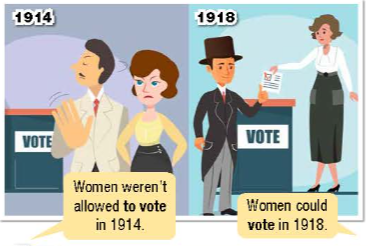Hãy nhập câu hỏi của bạn vào đây, nếu là tài khoản VIP, bạn sẽ được ưu tiên trả lời.

Đáp án: a. Women's rights in the past (Quyền của phụ nữ trong quá khứ)
Phương pháp giải:
Bài nghe:
Emma: Excuse me, Grandma, can you help me with my history project?
Donna: Yes, Emma. What would you like to know?
Emma: I'm trying to find out what life was like for women a hundred years ago.
Donna: Well, I'm not that old, but I can tell you what it was like for my mother.
Emma: Great. Is it true that women couldn't vote a hundred years ago?
Donna: That's right. Women won the right to vote in 1920.
Emma: What other things couldn't women do?
Donna: They couldn't do a lot of jobs. Most women stayed at home or did low paid jobs.
Emma: What kind of jobs were they able to do?
Donna: Store clerks, office workers, and factory workers. Things like that.
Emma: How much money did they earn?
Donna: Not much. My mom worked in a shoe factory, and she watched men earn more money than her, even though they were doing the same job.
Emma: What? That's not fair!
Donna: I know. It made her really angry. It wasn't until the 1960s that the government made employers pay their workers equally.
Emma: Were women allowed to own property back then?
Donna: Yes, but it wasn't easy. Banks wouldn't let unmarried women borrow money.
Emma: Really?
Donna: Yes. Banks would lend money to married women, but the husband still owned the property.
Emma: Thanks so much, Grandma.
Donna: You're welcome.
Tạm dịch:
Emma: Xin lỗi, bà có thể giúp cháu với dự án lịch sử của cháu không ạ?
Donna: Ừm, Emma. Cháu muốn biết về điều gì?
Emma: Cháu đang cố gắng tìm hiểu xem cuộc sống của phụ nữ một trăm năm trước như thế nào.
Donna: Chà, bà không già đến thế, nhưng bà có thể kể cho cháu nghe mẹ của bà đã như thế nào.
Emma: Tuyệt vời. Có đúng là phụ nữ không thể bầu cử một trăm năm trước không ạ?
Donna: Đúng vậy. Phụ nữ đã giành được quyền bầu cử vào năm 1920.
Emma: Phụ nữ không thể làm những việc gì khác ạ?
Donna: Họ không thể làm được nhiều việc. Hầu hết phụ nữ ở nhà hoặc làm những công việc được trả lương thấp.
Emma: Họ có thể làm những công việc gì ạ?
Donna: Nhân viên cửa hàng, nhân viên văn phòng và công nhân nhà máy. Đại loại như thế.
Emma: Họ đã kiếm được bao nhiêu tiền?
Donna: Không nhiều. Mẹ của bà làm việc trong một xưởng đóng giày, và bà chứng kiến những người đàn ông kiếm được nhiều tiền hơn mình, mặc dù họ làm cùng một công việc.
Emma: Thật ạ? Điều đó không công bằng!
Donna: Bà biết. Nó khiến bà ấy thực sự tức giận. Mãi cho đến những năm 1960, chính phủ mới yêu cầu người sử dụng lao động trả công bằng cho công nhân của họ.
Emma: Hồi đó phụ nữ có được phép sở hữu tài sản không ạ?
Donna: Có, nhưng nó không dễ dàng. Các ngân hàng sẽ không cho phụ nữ chưa lập gia đình vay tiền.
Emma: Thật ạ?
Donna: Ừm. Các ngân hàng sẽ cho phụ nữ đã lập gia đình vay tiền, nhưng người chồng vẫn sở hữu tài sản.
Emma: Cảm ơn bà nhiều lắm ạ.
Donna: Không có gì cháu à.

1: Lena asked what life had been like for women in the 1930s
2: Jolie said most women had stayed at home or had done low paid jobs
3: Jolie said many women hadn’t been allowed to choose their husbands

One hundred years ago, women didn’t have the right to vote, and few were allowed to pursue further education or important careers outside of their family duties.

Today, woman can vote and run for office.
(Ngày nay, phụ nữ có thể bầu cử và điều hành văn phòng.)




Phương pháp giải:
Meaning and Use (Ý nghĩa và Cách sử dụng)
We use the infinitives to add more information and to explain the reason for something or its purpose.
(Chúng ta sử dụng các động từ nguyên mẫu để bổ sung thêm thông tin và giải thích lý do cho điều gì đó hoặc mục đích của nó.)
Women started to fight for their rights.
(Phụ nữ bắt đầu đấu tranh cho quyền của họ.)